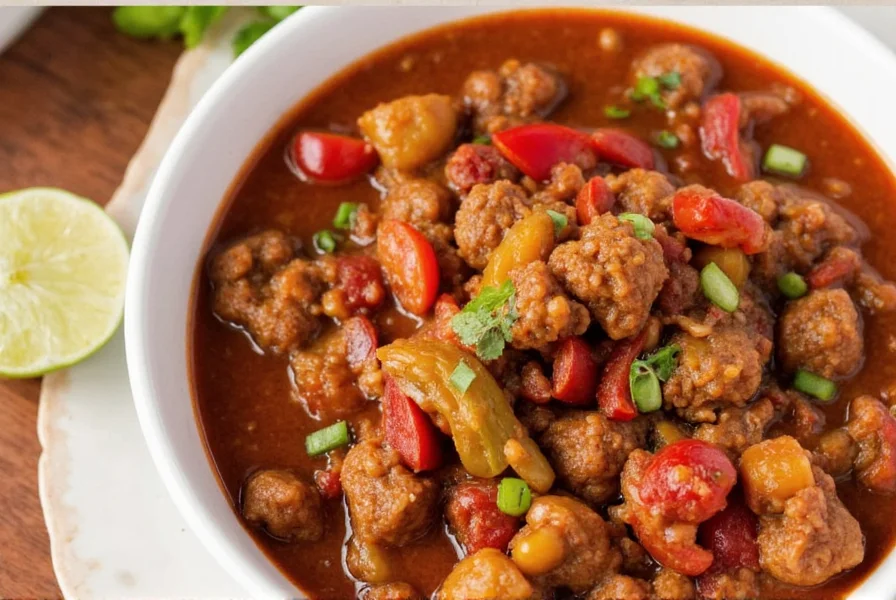Cuban sofrito is a flavorful base made from tomatoes, onions, green peppers, garlic, and spices. Here's how to make it in 20 minutes:
Ingredients:
- 2 large tomatoes, chopped
- 1 medium onion, chopped
- 1 green bell pepper, chopped
- 3 cloves garlic, minced
- 1 teaspoon dried oregano
- 1 teaspoon ground cumin
- 1/2 teaspoon paprika (optional)
- 1 tablespoon olive oil
- Salt and pepper to taste
Instructions:
- Heat the olive oil in a large pan over medium heat.
- Add the onion and green pepper, and sauté until softened.
- Add the garlic and cook for another minute.
- Stir in the tomatoes, oregano, cumin, paprika, salt, and pepper.
- Cook for 15–20 minutes, stirring occasionally, until the mixture thickens and the flavors meld together.
- Let it cool before using or storing in an airtight container in the fridge for up to a week, or freeze for longer storage.
| Base | Origin | Key Ingredients | Flavor Profile |
|---|---|---|---|
| Cuban Sofrito | Cuba | Tomatoes, onion, green pepper, garlic, oregano, cumin | Bold, savory, slightly sweet |
| Spanish Sofrito | Spain | Tomatoes, onion, garlic, bell pepper, saffron | Savory, aromatic, subtle |
| Italian Sugo | Italy | Tomatoes, onion, garlic, olive oil, herbs | Tangy, herbaceous, rustic |
| Indian Masala | India | Onion, garlic, ginger, chili, garam masala | Spicy, fragrant, intense |
Tips for the Perfect Sofrito
- Use fresh ingredients: Fresh tomatoes, onions, and herbs make a huge difference. Avoid pre-chopped or canned versions if possible.
- Don't rush the cooking: Letting the sofrito simmer allows the flavors to develop fully. You'll be rewarded with a richer, more complex taste.
- Adjust the spice level: If you like it hotter, add a pinch of red pepper flakes or a chopped jalapeño. For a milder version, skip the cumin or paprika.
- Experiment with herbs: While oregano and cumin are traditional, you can try adding thyme, bay leaves, or even a splash of lime juice for a twist.
- Freeze in portions: Make a big batch and freeze individual servings for quick use in future meals.

What Is Cuban Sofrito?
Cuban sofrito is a flavorful base made from a blend of tomatoes, onions, green peppers, garlic, and a variety of herbs and spices. It's the foundation of countless Cuban dishes like arroz con pollo, black beans, and even empanadas. Unlike other soffriti from different cuisines, Cuban sofrito is known for its boldness, with a balance of sweetness, acidity, and heat.
The word "sofrito" itself means "to cook slowly," which is exactly what happens when making this dish. It's not just about throwing ingredients into a pot—it's about layering flavors over time, allowing each component to shine and complement the others.
Frequently Asked Questions (FAQ)
What is the difference between Cuban sofrito and Spanish sofrito?
While both are flavor bases, Cuban sofrito typically includes tomatoes as a primary ingredient and has a bolder, more robust flavor profile with spices like cumin and oregano. Spanish sofrito often uses more olive oil and emphasizes the sweetness of slowly cooked onions and tomatoes, with ingredients like saffron giving it a distinctive flavor.
Can I make Cuban sofrito without tomatoes?
While traditional Cuban sofrito includes tomatoes, you can make a version without them. However, this would deviate from the authentic recipe. The tomatoes provide acidity and sweetness that balance the other ingredients. If you must omit them, consider adding a splash of tomato paste diluted with water or a small amount of vinegar for acidity.
How long does homemade Cuban sofrito last in the refrigerator?
Homemade Cuban sofrito will keep for up to 7 days in the refrigerator when stored in an airtight container. For longer storage, you can freeze it in portions for up to 3 months. Many cooks prefer to freeze sofrito in ice cube trays, then transfer the frozen cubes to a freezer bag for easy portioning.
What dishes can I use Cuban sofrito in?
Cuban sofrito is incredibly versatile! It's essential for traditional dishes like ropa vieja, picadillo, and arroz con pollo. It also works wonderfully as a base for black beans, lentils, soups, stews, and even as a flavor enhancer for rice. Some creative cooks use it as a pizza sauce base or mixed into scrambled eggs for extra flavor.
Can I substitute ingredients in Cuban sofrito?
Yes, but with some considerations. The "holy trinity" of Cuban sofrito is onions, green peppers, and garlic - these are difficult to substitute without changing the fundamental character. However, you can adjust spices to taste: oregano can be partially substituted with thyme, cumin can be reduced if you prefer milder flavor. For tomatoes, ripe plum tomatoes are preferred but other varieties can work. Remember that substitutions will create a different flavor profile.
Why is my sofrito too watery?
This usually happens when the vegetables haven't cooked long enough to release and then evaporate their moisture. Continue cooking over medium-low heat, stirring occasionally, until the mixture thickens. Tomatoes especially release a lot of liquid that needs time to cook down. If you're in a hurry, you can increase the heat slightly, but be careful not to burn it.
Conclusion
Cuban sofrito is more than just a cooking ingredient—it's a symbol of tradition, culture, and flavor. From its roots in Cuban kitchens to its global appeal, this versatile base brings warmth and depth to every meal it touches. Whether you're making it from scratch or buying a pre-made version, the key is to embrace the spirit of Cuban cuisine and let the flavors shine.
So next time you're in the kitchen, give Cuban sofrito a try. With its bold taste and rich history, it's sure to become a favorite in your culinary repertoire. After all, what's life without a little spice—and a lot of flavor?










 浙公网安备
33010002000092号
浙公网安备
33010002000092号 浙B2-20120091-4
浙B2-20120091-4